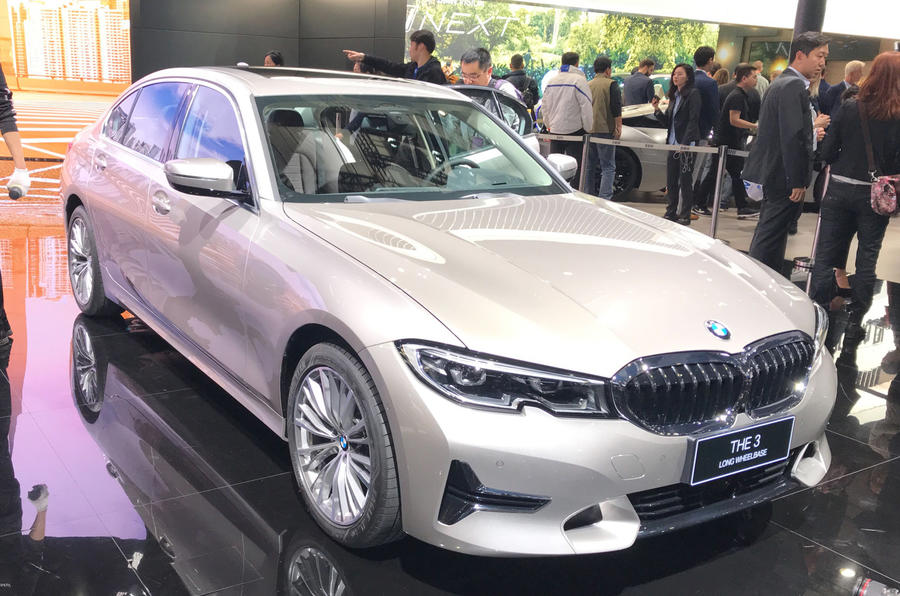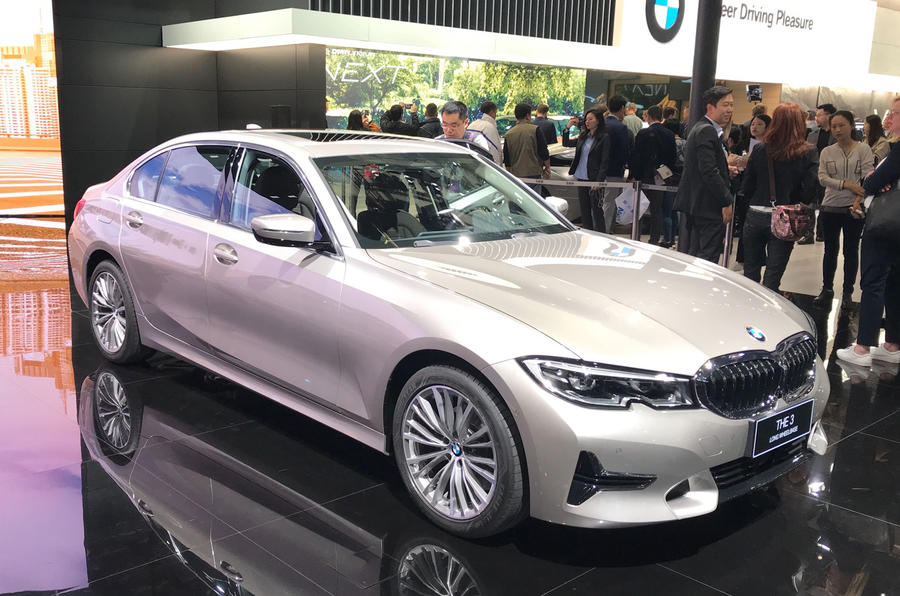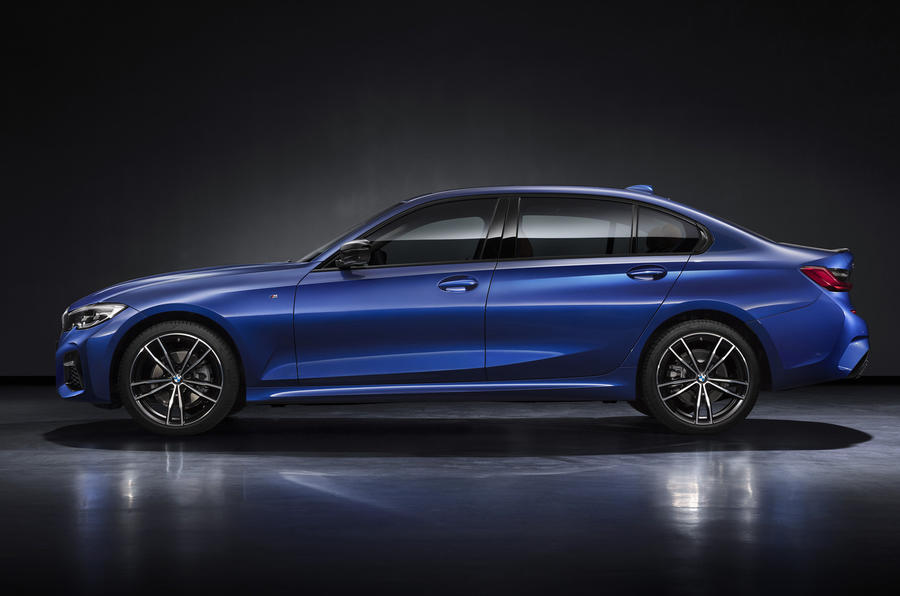The new BMW 3-series’ styling has been leaked before its official debut at the Paris motor show. Images surfaced online reveal the car’s fresh look and overhauled interior.
The images are taken from a 3-series configurator released early, which shows the car's evolutionary look, with simplified rear end and more dramatic fascia. The shots surfaced online just yesterday.
It also confirms the introduction of a rear-wheel-drive M340i M Performance model, which will feature a 365hp version of BMW’s 3.0-litre, inline, six-cylinder, twin-scroll turbocharged petrol engine. It will be followed by a four-wheel-drive M340d xDrive M Performance, which is set to receive a 324hp version of the company’s twin-turbocharged 3.0-litre inline six-cylinder diesel engine.
The 3-series will also be offered with more variants, including new M-fettled versions that feature generous boosts in performance.
Key to the expansion plan for the seventh-generation 3-series is the addition of two new M Performance models powered by six-cylinder engines. In a strategy mirroring that undertaken with the latest 5-series, the new M Performance variants will go on sale shortly after more mainstream versions of the new 3-series are launched in both sedan and estate body styles. The new derivatives will be offered as either a petrol or a diesel and will bridge the gap in the line-up that presently exists between standard six-cylinder models and BMW M’s range-topping M3 sedan.
The new performance-oriented 3-series models will be targeted at the likes of the Audi S4 quattro and Mercedes-AMG C43 4Matic. They will have individual styling touches, their own unique chassis tuning and relatively high equipment levels. Autocar can reveal they will also form the basis for the two-door M440i M Performance Coupé and M440d M Performance Coupé models, which will arrive in showrooms in 2020.
Significantly, the decision to launch the M340d xDrive M Performance model underpins plans by BMW to continue to equip the 3-series with a full range of three, four and six-cylinder diesel engines, despite increasingly tight emissions legislation across Europe, including the spectre of regional bans on diesel cars from entering city centres (some of which may be implemented in Germany).
A recent preview video showed the car under construction at its Dingolfing plant, with elements of the car's exterior shown, as well as its interior – in particular, its digital dashboard and wide, high-mounted central infotainment screen – while the shots show fragments of the car's inside and exterior. These follow BMW's first preview of the car, showing the outline of the 3-series under a sheet, with the car's distinctive daytime running lights highlighting extra details. The image first surfaced on BMW forums, but the brand confirmed that the preview is genuine.
The upcoming Mercedes-Benz C-class rival was most recently spotted in Touring guise, being put through its paces at the Nurburgring, ahead of its launch early next year.
Spy photographers captured this camouflaged test mule undergoing high-speed testing, with extra panels riveted in place towards the rear end to disguise the cargo area. It is also sporting the redesigned headlights and tail-lights that will set it apart from the outgoing model.
The Touring is expected to go on sale shortly after the sedan, which BMW is due to reveal at the Paris Motor Show. Other variants should follow later in the year, with a plug-in hybrid model completing the line-up.
This latest sighting follows photos of a '330e' plug-in hybrid model, which looks like a regular 3-series but has “Electric Test Vehicle” written on each side.
Further clues include a small lump in the C-pillar disguise, exactly where BMW has traditionally placed the ‘eDrive’ badge on its plug-in models. The car was also seen later on the same road, as well as in the recent preview images, with its kidney grille blanked off, suggesting an active aerodynamic shutter system may feature on the new car.
Unusually, the 330e was spotted testing alongside a Tesla Model 3 on tow. A fully electric 3-series is not expected, with that car instead set to be part of the 4-series line-up. It’s a sign, however, that BMW is benchmarking its car’s all-electric mode with a similarly-sized full EV.
As such, expect a substantial increase in electric range and a minor performance boost with the next 330e, which could arrive early next year. The current car combines a 2.0-litre turbocharged petrol engine with an 88hp electric motor, promising an all-electric range of 40km and a 0-100kph time of 6.1sec.
The 330e is set to become a more crucial model in the range, thanks to the drop in demand for diesel models. There is even potential for BMW to offer a lower-powered, even more efficient version to plug the fleet-biased gap in the range historically filled by the 320d. That powertrain could use the new three-cylinder engine that’ll feature in the 318i and build on it with an electric motor and lithium-ion battery pack. More variants of the 3-series will go on sale throughout 2019 after its initial launch.
Previous spy shots had captured a disguised version of the 3-series Touring testing on public roads in Germany, hinting at how the most practical variant of the G20-generation car will look when it hits roads next year.
Both the Touring and sedan versions of BMW's future model are being engineered to offer even more comfort but not to the detriment of handling. This means the whole range — even sportier versions such as the just-spotted M Sport variant — should be more forgiving on rough surfaces than before.
The motivation for this more comfortable model comes from hot competition from Mercedes-Benz and its rivalling C-class. Although the 3-series stands strong as BMW's best-selling model, it's fallen short of the hot-selling C-class, which sold in 1,76,915 units to the 3-series' 1,29,053 in 2017.
As such, BMW engineers have been tasked with broadening the 3-series' reach and fighting the C-class at its own, more comfort-focused game.
BMW benchmarks C-class for new 'G20' 3-series
BMW is pulling out all the stops to ensure the new 3-series, which goes under the internal codename G20, possesses the stylistic appeal, performance credentials, dynamic ability and overall technical prowess it needs to claw back the gains made by its keenest executive class rivals, most notably the C-class, which officials have as the clear benchmark.
Prototype sedan versions of the new 3-series spied testing on the roads around BMW’s engineering headquarters in Munich recently indicate it will continue the company’s tradition of evolutionary design change, with an appearance that leans heavily on that of the larger 5-series, as well as influence from the X2 SUV. The car has a more naturally sporting stance to mirror the changes beneath.
Credit for the design of the new model rests with former BMW brand design boss, Karim Habib, who moved to Infiniti last year.
As the first 3-series model to be fully honed in BMW’s Munich-based wind tunnel, the G20 is also claimed to match the aerodynamic efficiency of the 5-series. The most slippery body style is said to have a drag co-efficient of 0.22.
The new 3-series has grown in most key dimensions. Nothing is official, but Munich insiders suggest overall length is up by 60mm to around 4,703mm. Some 20mm of this is said to be concentrated within a lengthened wheelbase, which has increased to almost 2,830mm, up from 2,810mm. By comparison, the current C-class is 4,696mm in length and has a 2,840mm wheelbase.
The new 3-series is based on BMW’s latest CLAR (cluster architecture) platform — as used by all recent BMW models — and features a longitudinally mounted engine. In keeping with developments already seen on the larger 5-series, it benefits from a range of weight-saving initiatives, including the greater use of hot-formed high-strength steel within the main body structure, to cut the already highly competitive kerb weight of today’s sixth-generation model by up to 50kg, despite the larger dimensions.
The volume of 3-series sales rules out the use of carbon-fibre, so there’ll be no Carbon Core structural developments like those seen on the headlining 7-series.
However, BMW’s body construction specialists suggest the G20 will feature a much larger number of cast aluminium components and a greater percentage of magnesium in load-bearing areas. All told, the weight-saving developments are expected to give the lightest variant in the range, the three-cylinder 318i, a kerb weight of about 1,425kg.
Together with the reduction in weight, the CLAR platform is also claimed to bring an improvement in structural rigidity that, in a move like that undertaken with the 5-series, forms the basis for a change in philosophy for the chassis tuning. Recognising a growing customer desire for additional ride comfort, BMW is looking to provide standard versions of the new 3-series with more compliant properties, in a move aimed at matching the smoothness of the C-class.
Expected developments include the adoption of rear air springs on more upmarket models. However, BMW is thought to have ruled out the active four-wheel steering system (that countersteers the rear wheels at lower speeds and parallel steers them at higher speeds in the name of agility), even though the 5-series is equipped with it.
In a continuation of the Efficient Dynamics programme that has seen successive reductions in consumption and emissions across the 3-series line-up over recent years, BMW plans to bring a series of upgrades to the petrol engine line-up of the new model.
BMW officials have confirmed an extension of the strategy in use today, with both three- and four-cylinder units serving volume-selling 316i, 318i, 320i and 330i models in combination with either standard rear-wheel drive and optional xDrive four-wheel drive on selected variants.
Positioned above them will be a six-cylinder engine offered in both a standard, rear-wheel drive 340i and the M340i M Performance guises.
BMW has begun to successively upgrade the petrol engines in each of its various model lines, with the recently revealed 2-series Active Tourer facelift being the most recent model to bear the tweaks. Measures such as a new injection system, a particulate filter to lower NOx levels, a revised belt drive system and more efficient cooling measures are claimed to bring moderate increases in power and torque.
Together with the reduction in kerb weight promised by the new CLAR underpinnings, the reworked petrol units are also said to offer consumption and emission savings of up to 5 percent across the model line-up.
Accompanying the petrol units will be range of diesels. Adopting developments first seen on the 2.0-litre unit used by today’s 325d, each new oil-burner will receive two-stage turbocharging and a selective catalytic reduction (SCR) filter as part of BMW’s efforts to reduce emissions.
The Bavarian manufacturer is also planning to equip up to three new 3-series variants with an upgraded version of today’s 3.0-litre inline six-cylinder diesel. They include the standard 330d and 340d, as well as the M340d xDrive M Performance diesel flagship.









































